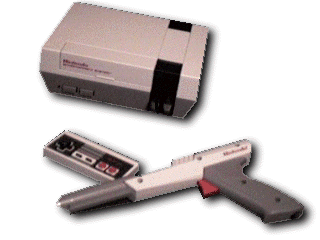

The Nintendo Entertainment System was released in the U.S. in 1985 after seeing some success in Japan as the Famicom [picture of Famicom cartridges]. Although there are some gems in the NES collection of titles, too many companies jumped into the reviving videogame market and flooded the NES with garbage, much like the plight of the 2600 just before the market crash. Nintendo put its "Seal of Quality" onto any game by producers willing to pay Nintendo's licensing fee, not necessarily the best games. In addition, Nintendo censored its U.S. releases, trying to protect its image but effectively alienating its over-13 market.
Although almost all games for the NES used its joypad-style controller, making it simple and easy to use, there were a few other controllers available. The light gun was a pack-in for most of the life of the NES. The game Arkanoid came with its own paddle controller. And while the NES didn't have anything equivalent to Atari's Mindlink, it had its share of strange accessories, including the Power Pad exercise mat, the U-Force 3-D controller which sensed the movement of a hand over its surface, the Power Glove virtual-reality-style glove, and the Robotic Operating Buddy (R.O.B.).
Nintendo re-released the NES in a smaller case and with a standard cartridge slot (instead of the "zero insertion force" slot in the original NES which was very dirt-prone) in 1993 and tried to push it in the coming Christmas season for $49. Before this, the older NES was selling for $10 less than the Super Nintendo--smart marketing on Nintendo's part, in getting a big user base for the SNES, but doing no good for the NES. Nintendo officially dropped it in 1995.
Dennis Brown, dgbrown (at) pixesthesia (dot) com, creator and maintainer. E-Mail me with corrections and additions. All contents copyright 2006, Dennis Brown. All trademarks are properties of their respective companies.